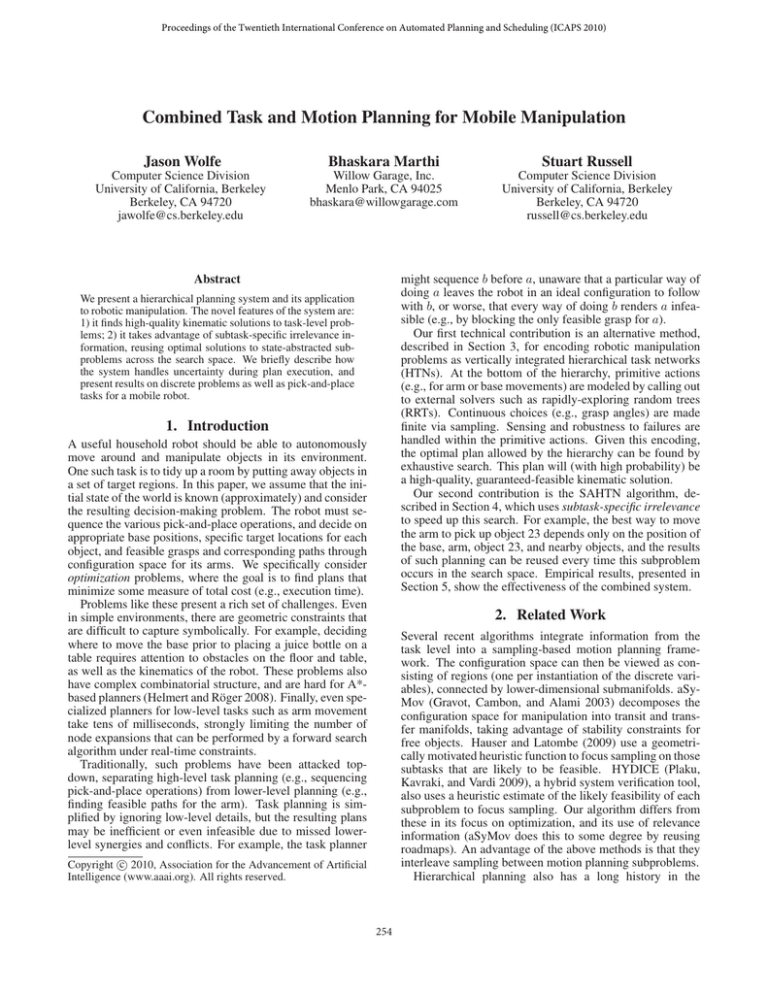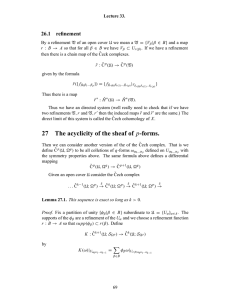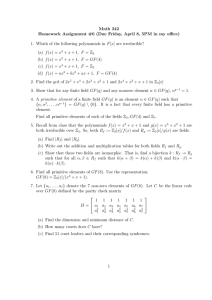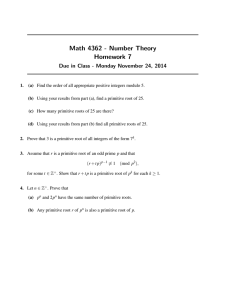
Proceedings of the Twentieth International Conference on Automated Planning and Scheduling (ICAPS 2010)
Combined Task and Motion Planning for Mobile Manipulation
Jason Wolfe
Bhaskara Marthi
Stuart Russell
Computer Science Division
University of California, Berkeley
Berkeley, CA 94720
jawolfe@cs.berkeley.edu
Willow Garage, Inc.
Menlo Park, CA 94025
bhaskara@willowgarage.com
Computer Science Division
University of California, Berkeley
Berkeley, CA 94720
russell@cs.berkeley.edu
might sequence b before a, unaware that a particular way of
doing a leaves the robot in an ideal configuration to follow
with b, or worse, that every way of doing b renders a infeasible (e.g., by blocking the only feasible grasp for a).
Our first technical contribution is an alternative method,
described in Section 3, for encoding robotic manipulation
problems as vertically integrated hierarchical task networks
(HTNs). At the bottom of the hierarchy, primitive actions
(e.g., for arm or base movements) are modeled by calling out
to external solvers such as rapidly-exploring random trees
(RRTs). Continuous choices (e.g., grasp angles) are made
finite via sampling. Sensing and robustness to failures are
handled within the primitive actions. Given this encoding,
the optimal plan allowed by the hierarchy can be found by
exhaustive search. This plan will (with high probability) be
a high-quality, guaranteed-feasible kinematic solution.
Our second contribution is the SAHTN algorithm, described in Section 4, which uses subtask-specific irrelevance
to speed up this search. For example, the best way to move
the arm to pick up object 23 depends only on the position of
the base, arm, object 23, and nearby objects, and the results
of such planning can be reused every time this subproblem
occurs in the search space. Empirical results, presented in
Section 5, show the effectiveness of the combined system.
Abstract
We present a hierarchical planning system and its application
to robotic manipulation. The novel features of the system are:
1) it finds high-quality kinematic solutions to task-level problems; 2) it takes advantage of subtask-specific irrelevance information, reusing optimal solutions to state-abstracted subproblems across the search space. We briefly describe how
the system handles uncertainty during plan execution, and
present results on discrete problems as well as pick-and-place
tasks for a mobile robot.
1. Introduction
A useful household robot should be able to autonomously
move around and manipulate objects in its environment.
One such task is to tidy up a room by putting away objects in
a set of target regions. In this paper, we assume that the initial state of the world is known (approximately) and consider
the resulting decision-making problem. The robot must sequence the various pick-and-place operations, and decide on
appropriate base positions, specific target locations for each
object, and feasible grasps and corresponding paths through
configuration space for its arms. We specifically consider
optimization problems, where the goal is to find plans that
minimize some measure of total cost (e.g., execution time).
Problems like these present a rich set of challenges. Even
in simple environments, there are geometric constraints that
are difficult to capture symbolically. For example, deciding
where to move the base prior to placing a juice bottle on a
table requires attention to obstacles on the floor and table,
as well as the kinematics of the robot. These problems also
have complex combinatorial structure, and are hard for A*based planners (Helmert and Röger 2008). Finally, even specialized planners for low-level tasks such as arm movement
take tens of milliseconds, strongly limiting the number of
node expansions that can be performed by a forward search
algorithm under real-time constraints.
Traditionally, such problems have been attacked topdown, separating high-level task planning (e.g., sequencing
pick-and-place operations) from lower-level planning (e.g.,
finding feasible paths for the arm). Task planning is simplified by ignoring low-level details, but the resulting plans
may be inefficient or even infeasible due to missed lowerlevel synergies and conflicts. For example, the task planner
2. Related Work
Several recent algorithms integrate information from the
task level into a sampling-based motion planning framework. The configuration space can then be viewed as consisting of regions (one per instantiation of the discrete variables), connected by lower-dimensional submanifolds. aSyMov (Gravot, Cambon, and Alami 2003) decomposes the
configuration space for manipulation into transit and transfer manifolds, taking advantage of stability constraints for
free objects. Hauser and Latombe (2009) use a geometrically motivated heuristic function to focus sampling on those
subtasks that are likely to be feasible. HYDICE (Plaku,
Kavraki, and Vardi 2009), a hybrid system verification tool,
also uses a heuristic estimate of the likely feasibility of each
subproblem to focus sampling. Our algorithm differs from
these in its focus on optimization, and its use of relevance
information (aSyMov does this to some degree by reusing
roadmaps). An advantage of the above methods is that they
interleave sampling between motion planning subproblems.
Hierarchical planning also has a long history in the
c 2010, Association for the Advancement of Artificial
Copyright Intelligence (www.aaai.org). All rights reserved.
254
directly over primitive action sequences, an agent can begin
with a plan consisting of just Act, and repeatedly replace
the first non-primitive action in this plan with an immediate
refinement until a primitive solution is found. We assume
WLOG that the hierarchy does not generate primitive nonsolutions. This can always be achieved, e.g., by ending each
plan with a Goal HLA that has zero refinements from nongoal states and an empty refinement from goal states.
Concretely, we use the following hierarchy. Act has recursive refinements MoveToGoal(o), Act ranging over all
objects o that are not yet in their goal positions, or just the
empty refinement if this set is empty. MoveToGoal(o) refines in turn to GoPick(o), GoPlace(o, p), ranging over
positions p in the goal region of o. Both of these HLAs refine
to ArmTuck, BaseRgn(r) if needed (where r is a region
around the target), followed by Pick(o) or Place(o, p).
Pick and Place further refine to choose a grasp/drop angle, and then generate the appropriate sequence of arm,
torso, and gripper primitives to effect the appropriate pick
or place operation.
As with the primitive transition models, we allow the set
of refinements of an HLA to be generated by arbitrary code.
This allows, e.g., GoPick to compute a candidate base region for the grasp, and Place to use inverse kinematics to
generate valid arm joint configurations for the drop. One
complication that arises in hybrid domains is that the set of
refinements of a high level action may be (uncountably) infinite. For example, the BaseRgn(r) action has one refinement BaseAction(p) for each point p in region r. We
make the search space finite by having each such HLA generate a random sample of pre-specified size from its infinite
set of refinements. The same random bits are used across invocations of an HLA, which produces a “graphy” reachable
state space that provides more opportunities for caching. For
instance, each time we consider Placeing a particular object we will generate the same candidate target positions.
Note that hierarchical constraints may rule out all optimal solutions; for instance, our hierarchy does not allow
putting an object down in an intermediate location. A plan
is called hierarchically optimal if has minimal cost among
all plans generated by the hierarchy. Moreover, let N be the
minimum number of samples used when discretizing the refinements of an HLA (or calling a sampling-based primitive
planner). A planning algorithm is hierarchically resolutionoptimal if, as N → ∞, the cost of the returned plan converges almost surely to the hierarchically optimal cost. Finally, define the reachable state space under a hierarchy as
the set of all states visited by any primitive refinement of
Act. In this paper, we assume that the reachable state space
is always finite, and restrict our attention to hierarchically
(resolution-) optimal planning algorithms.
discrete planning literature, and hierarchical task network
(HTN) planners such as SHOP2 (Nau et al. 2003) have been
widely used in practice. The rich geometry of robotic configuration spaces seems difficult to express using standard
discrete representations alone, though, and so these methods
have tended to stay above the motion planning level. Moreover, little work has been done on optimization for HTNs.
Abstracting a problem using a subset of state variables
has also been considered by many researchers. Most work
we are familiar with in the planning literature uses abstraction to create a simpler approximation to the problem,
whose solution is then expanded (Sacerdoti 1973) or used
as a heuristic (Culberson and Schaeffer 1996; Holte, Grajkowski, and Tanner 2005; Felzenszwalb and McAllester
2007). For the related problem of learning or deriving an
optimal policy, prior work in the reinforcement learning literature (Dietterich 2000; Diuk, Strehl, and Littman 2006)
uses an exact abstraction to reduce the size of the value function or policy representation. Finally, cognitive architectures
such as SOAR (Laird, Newell, and Rosenbloom 1987) use
explanation-based learning to avoid deliberating about the
same subproblem twice; however, these systems do not do
optimal planning, and are not explicitly hierarchical.
3. Pick-and-Place Domain and Hierarchy
We consider a pick-and-place domain for a mobile robot
with arm(s), where the environment consists of objects
(juice bottles) on various surfaces. The robot’s task is to
move all objects to their goal regions, as quickly as possible.
States for this problem consist of a robot joint configuration, along with, for each object, a description of its geometry, current position, and relation to other objects (e.g.,
bottle1 on table1).
The primitive actions in this domain move a specific part
of the robot (base, torso, arm, or gripper) to a target joint
configuration. One additional action moves the arm into a
grasp configuration given the approximate location of a target object and a grasp angle (this action is represented as
primitive because it involves perceptual feedback from the
laser scanner, and our planner assumes full observability).
For each primitive action, we require a transition model
that takes in a state and returns the successor state and action
cost (or failure). The complex geometric constraints in the
environment make it difficult to use declarative representations such as PDDL directly. Instead, the transition models
are procedural, and call out to external planners. For example, ArmJointAction is implemented by a samplingbased motion planner (Rusu et al. 2009), using a collision
map rendered from the current state. Action costs are set
based on the estimated time required. For example, the cost
of ArmJointAction is the length of the returned path,
multiplied by a weighting constant.
In addition to an initial state and transition model, our
planning algorithm also takes a action hierarchy as input.
This hierarchy specifies 1) a finite set of high-level actions
(HLAs), including a distinguished top-level action Act; and
2) for each HLA and state, a set of immediate refinements
into finite sequences of (possibly high-level) actions.
Such a hierarchy both structures and potentially restricts
the space of solutions. In particular, rather than searching
4. SAHTN Algorithm
This section presents the State-Abstracted Hierarchical Task
Network (SAHTN) algorithm. It takes in a domain description, action hierarchy, and a RELEVANT- VARS function specifying which state variables matter for doing an action from
some state. The output is a hierarchically optimal solution.
As a stepping stone towards describing SAHTN, we first
present a simple exhaustive, hierarchically optimal HTN al-
255
all aspects of state s that are relevant to doing action a:
Definition 1. A state variable v is relevant to action a from
state s, iff (1) the set of primitive refinements of a from s
depends on v, or (2) any primitive refinement of a from s
conditions on, sets, or has cost dependent on the value of v.
For example, the only variables relevant to
BaseAction(p) are the the current base position,
and the positions of objects that are potential obstacles.1
Before stating the correctness of SAHTN, there is one
more issue that must be made concrete. As described, the
algorithm will loop forever in cyclic hierarchies; we first define this condition, and later discuss how it can be relaxed.
Definition 2. Call pair (s , a ) a subproblem of (s, a) iff
there exists a refinement r of a from s and integer i s.t.
s = SUCCESSOR(s, r1:i−1 ) and a = ri . A hierarchy is
cyclic from initial state s iff there exists any subproblem of
(s, Act) that has itself as a subproblem.
Equivalently, a hierarchy is cyclic if SAHTN ever recursively calls R ESULTS -A(s, a) when R ESULTS -A(s, a) is already on the call stack. Note that an acyclic hierarchy may
include recursive HLAs. For instance, while the Act HLA
for our pick-and-place domain is recursive, the hierarchy is
not cyclic because in every recursive application of Act, one
more object will have been placed in its goal position.
Theorem 1. Given an acyclic hierarchy, correct RELEVANTVARS function, and finite reachable state space, SAHTN will
always return a hierarchically optimal solution.2
The acyclic requirement can rule out some natural hierarchies. For instance, consider a Nav(x, y) HLA in a gridworld domain, which refines to the empty sequence iff at
(x, y), and otherwise to a primitive move action followed by
a recursive Nav(x, y). In this case, the refinement Left,
Right, Nav(x, y) leads to a cycle in the above sense. Fortunately, a simple change to SAHTN can extend Theorem 1
to such cases. The basic idea is to add a case to R ESULTS A: if (s, a) potentially leads to a cycle, instead of recursively
decomposing run Dijkstra’s algorithm locally over the space
of potential cycles, switching back to recursive computation
for (s , a ) pairs that can not cycle back to (s, a).2
Algorithm 1 : Optimal HTN algorithm for acyclic problems
/* s is a state, a is an action, p is a plan (action sequence), and
* c is its corresponding cost. The MERGE function merges maps,
* retaining the minimum-cost entry for each reachable state. */
function S OLVE(s)
return the plan associated with the min-cost state
in R ESULTS -A(s, Act), or failure if empty
function R ESULTS -A(s, a)
if a is high-level then
return MERGE({R ESULTS -P(s, ref ) |
ref ∈ REFINEMENTS(a, s)})
else if ¬APPLICABLE(s, a) then return { }
else return {SUCCESSOR(s, a) : [COST(s, a), [a]]}
function R ESULTS -P(s, p)
output ← {s : [0, [ ]]}
for each a in p do
output ← MERGE({B OOKKEEP -A(s , a , c , p ) |
s : [c , p ] ∈ output})
return output
function B OOKKEEP -A(s, a, c, p)
output ← {}
for each s : [c , p ] ∈ R ESULTS -A(s, a) do
output[s ] ← [c + c , p + p ]
return output
Algorithm 2 : Changes to Algorithm 1 for SAHTN algorithm
function B OOKKEEP -A(s, a, c, p)
relevant ← RELEVANT- VARS(s, a)
if cache has no entry for [srelevant , a] then
cache[srelevant , a] ← R ESULTS -A(s, a)
output ← {}
for each s : [c , p ] ∈ cache[srelevant , a] do
output[srelevant + srelevant ] ← [c + c , p + p ]
return output
gorithm (see Figure 1). The top-level S OLVE function takes
an initial state, and returns a hierarchically optimal solution
(or failure). R ESULTS -A and R ESULTS -P take an initial
state and action or plan, and return a map from each state
reachable by (some refinement of) the given action or plan
to a tuple containing an optimal primitive refinement that
reaches this state and its cost (cf. the exact valuations of
Marthi, Russell, and Wolfe (2008)). In particular, R ESULTS A returns the single outcome state for a primitive action, or
the best cost and plan to each reachable state (over all refinements) for a high-level action. R ESULTS -P computes the result for an action sequence by progressing through each action in turn. Finally, B OOKKEEP -A simply calls R ESULTS A, with some extra bookkeeping to sum optimal costs and
concatenate optimal plans along action sequences.
SAHTN (see Algorithm 2) makes this into a dynamic programming algorithm by adding state-abstracted caching to
the B OOKKEEP -A function. We assume a global cache of
the results of each call to R ESULTS -A(s, a), keyed by a and
the values of state variables in s that are relevant to a from s.
Then, in a later call to R ESULTS -A(s , a) where s has the
same relevant variable values as s, we simply look up the
cached result and combine it with the irrelevant variables of
s to produce the output mapping. For this output to be correct, it is crucial that RELEVANT- VARS(s, a) truly captures
5. Results
We now present comparisons of SAHTN with three other
search algorithms. Uniform-cost search (UCS) searches forward from the initial state, without using a hierarchy. Hierarchical UCS (H-UCS) searches in a space where each node
consists of the state arising from the primitive prefix of a
plan, together with the remaining actions in the plan. NSAHTN is the SAHTN algorithm with no state abstraction.
We first present results on a version of the taxi domain,
a benchmark commonly used in the reinforcement learning
literature (Dietterich 2000). Taxi problems consist of a taxi
1
With appropriate changes to the algorithm, more general notions of relevance can be considered as well. For instance, in a multi-robot problem one could share results between
MoveToGoal(robot1, o) and MoveToGoal(robot2, o) for interchangeable robots with identical starting configurations.
2
Proof and other supplemental materials are available at
www.ros.org/wiki/Papers/ICAPS2010_Wolfe
256
50x50 taxi problems
robotic pick-and-place problems
100
runtime (s)
runtime (s)
1000
10
H-UCS
N-SAHTN
UCS
SAHTN
1
2
4
6
8
# of passengers
10
H-UCS
N-SAHTN
SAHTN
100
10
12
1
Figure 1: Runtimes for algorithms on 50x50 taxi problems, as a
function of the number of passengers. Larger problems were not
solvable by any algorithm but SAHTN within 512MB of memory.
2
3
4
# of objects to move
5
6
Figure 2: Runtimes (averaged over three runs) for three algorithms
on pick-and-place tasks, as a function of the number of objects to
be moved. Larger problems were not solvable by any algorithm
except SAHTN within 10 min. Two runs where unlucky sampling
led to no solutions being found were discarded and rerun.
in a grid world, and passengers with randomly chosen source
and destination squares. The taxi must pick up and drop off
the passengers, one at a time. On such problems (see Figure 1), SAHTN (with the Dijkstra modification mentioned
above) clearly scales much better than other algorithms as
the number of passengers increases, due to decoupling of
navigation decisions from high-level sequencing of passengers. All algorithms are primitive-optimal in this domain.
We next evaluated our algorithms on the full pick-andplace domain, using a prototype PR2 robot constructed by
Willow Garage, Inc (Wyrobek et al. 2008). The robot has
a wheeled base and two 7-dof arms (including 1-dof gripper). Figure 2 shows results on single-arm pick-and-place
tasks with two tables and randomly placed objects and goal
regions, for increasing numbers of objects. There is no obvious way to apply uniform-cost search to these problems, so
we compare the three other algorithms (all of which take advantage of our hierarchical problem formulation), using the
same sampling settings. We again see significant improvement in runtime from state abstraction in SAHTN, increasing as the number of objects grows. SAHTN’s performance
is initially dominated by the polynomially many primitive
action applications it must make, although eventually the
exponential cost of the top-level traveling salesman problem
will take over.
We also implemented, for each primitive action, a function to execute it on the PR2. The execution primitives were
responsible for implementing perceptual feedback and returning a success flag, which was used to implement a simple executive that retried failed actions. A video of the PR2
executing a 4-object plan is available online.2
References
Culberson, J. C., and Schaeffer, J. 1996. Searching with Pattern
Databases. In Advances in Artificial Intelligence (Lecture Notes in
Artificial Intelligence 1081, 402–416.
Dietterich, T. G. 2000. Hierarchical Reinforcement Learning with
the MAXQ Value Function Decomposition. JAIR 13:227–303.
Diuk, C.; Strehl, A. L.; and Littman, M. L. 2006. A Hierarchical Approach to Efficient Reinforcement Learning in Deterministic
Domains. In AAMAS, 313–319.
Felzenszwalb, P. F., and McAllester, D. 2007. The Generalized A*
Architecture. J. Artif. Int. Res. 29(1):153–190.
Gravot, F.; Cambon, S.; and Alami, R. 2003. aSyMov: A Planner
That Deals with Intricate Symbolic and Geometric Problems. In
ISRR, 100–110.
Hauser, K., and Latombe, J. C. 2009. Integrating Task and PRM
Motion Planning. In Workshop on Bridging the Gap between Task
and Motion Planning, ICAPS 2009.
Helmert, M., and Röger, G. 2008. How Good is Almost Perfect?
In AAAI, 944–949.
Holte, R. C.; Grajkowski, J.; and Tanner, B. 2005. Hierarchical
Heuristic Search Revisited. In SARA, 121–133.
Laird, J. E.; Newell, A.; and Rosenbloom, P. S. 1987. SOAR: an
Architecture for General Intelligence. Artif. Intell. 33(1):1–64.
Marthi, B.; Russell, S. J.; and Wolfe, J. 2008. Angelic Hierarchical
Planning: Optimal and Online Algorithms. In ICAPS.
Nau, D.; Au, T. C.; Ilghami, O.; Kuter, U.; Murdock, W. J.; Wu,
D.; and Yaman, F. 2003. SHOP2: An HTN planning system. JAIR
20:379–404.
Plaku, E.; Kavraki, L. E.; and Vardi, M. Y. 2009. Hybrid systems:
from verification to falsification by combining motion planning and
discrete search. Formal Methods in System Design 34(2):157–182.
Rusu, R. B.; Şucan, I. A.; Gerkey, B.; Chitta, S.; Beetz, M.; and
Kavraki, L. E. 2009. Real-time perception guided motion planning
for a personal robot. In IEEE/RSJ International Conference on
Intelligent Robots and Systems, 4245–4252.
Sacerdoti, E. D. 1973. Planning in a Hierarchy of Abstraction
Spaces. In IJCAI, 412–422.
Wyrobek, K. A.; Berger, E. H.; der Loos, H. F. M. V.; and Salisbury,
J. K. 2008. Towards a personal robotics development platform:
Rationale and design of an intrinsically safe personal robot. In
ICRA, 2165–2170.
6. Conclusion
We view this work as a proof-of-concept that task-level planning can be successfully extended all the way to the kinematic level, to generate robust and high-quality plans. To
help reduce computation times for larger tasks, future work
will examine extensions of SAHTN that can use available
heuristic information, and perhaps approximate models for
the HLAs and primitives (Marthi, Russell, and Wolfe 2008),
to guide search and reduce calls to external solvers. Another
important improvement will be incremental, adaptive search
algorithms that better manage the tradeoff between computational cost and plan quality.
257





